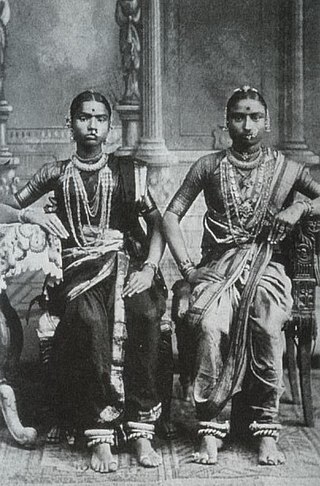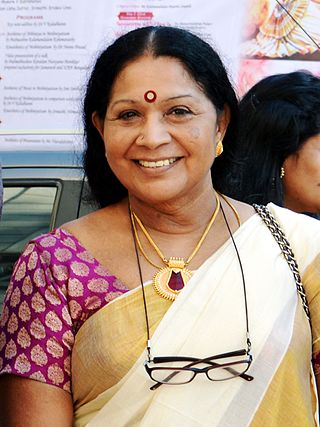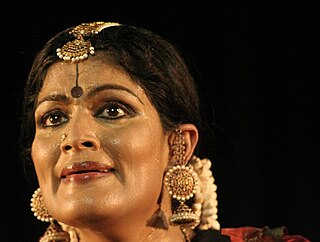Related Research Articles

Bharatanatyam is an Indian classical dance form that originated in India. It is a classical dance form recognized by the Sangeet Natak Akademi, and expresses South Indian religious themes and spiritual ideas, of Hinduism and Jainism.

Shobana Chandrakumar Pillai is an Indian actress and Bharatanatyam dancer. She acts predominantly in Malayalam films along with Telugu, Tamil, Hindi, Kannada and English films. She has won two National Film Awards, one Kerala State Film Awards, two Filmfare Awards South with 14 Nominations for Best Actress Category in three different south Indian languages, Tamil Nadu State's Kalaimamani Award in 2011 and numerous other awards. In a career spanning more than 40 years, Shobana has starred in 230 films across several languages predominantly in Malayalam, besides Tamil, Telugu, Kannada, Hindi and English.

In India, a devadasi is a female artist who is dedicated to the worship and service of a deity or a temple for the rest of her life. The dedication takes place in a ceremony that is somewhat similar to a marriage ceremony. In addition to taking care of the temple and performing rituals, these women also learn and practice classical Indian dances such as Bharatanatyam, Mohiniyattam, Kuchipudi, and Odissi. Their status as dancers, musicians, and consorts was an essential part of temple worship.

Rukmini Devi Arundale was an Indian theosophist, dancer and choreographer of the Indian classical dance form of Bharatanatyam, and an activist for animal welfare.

Tanjore Balasaraswati, also known as Balasaraswati, was an Indian dancer, and her rendering of Bharatanatyam, a classical dance style originated in the South Indian state of Tamil Nadu, made this style of dancing well known in different parts of India and many parts of the world.
Swarnamalya Ganesh is an Indian dancer, actress, Model and TV anchor.

Chitra Visweswaran is an Indian Bharata Natyam dancer who runs a dance school, the Chidambaram Academy of Performing Arts, in Chennai.
E. Krishna Iyer was an Indian lawyer, freedom-fighter, classical artist and activist. He was the follower of traditional Isaivellalar practitioners of Sadir, also known as Bharatanatyam.
K. P. Kittappa Pillai was the son of Sangita Kalanidhi K. Ponniah Pillai (1888-1945), a scion of the famous Tanjore Quartet, codifiers of the Bharatanatyam format.

Kalamandalam Kshemavathy is a Mohiniyattam dancer from Thrissur, Kerala. She is an alumna of the Kerala Kalamandalam. She joined the institute when she was ten. After completion of the course, she undertook advanced training in Bharata Natyam under Muthuswamy Pillai and Chitra Visweswaran, and in Kuchipudi under Vempati Chinna Satyam, but chose to remain within the Mohiniyattam tradition.

Saroja Vaidyanathan was an Indian choreographer, guru, and notable proponent of Bharatanatyam. She was conferred the Padma Shri in 2002 and the Padma Bhushan in 2013 by the Government of India.
The Madras Devadasis Act is a law that was enacted on 9 October 1947 just after India became independent from British rule. The law was passed in the Madras Presidency and gave devadasis the legal right to marry and made it illegal to dedicate girls to Hindu temples. The bill that became this act was the Devadasi Abolition Bill.
Madras Kadiravelu Saroja, known as Puliyur Saroja, was an Indian classical dancer, known for her expertise, as an exponent and as a teacher, in the classical dance form of Bharatanatyam. The Government of India honored her, in 2011, with the Padma Shri, the fourth highest civilian award, for her services to the field of art and culture.
Davesh Soneji is a social historian working in the field of performing arts, addressing issues of gender, class, and caste especially in the colonial context. He teaches in the Department of South Asia Studies at the University of Pennsylvania. His work focuses on religion and the performing arts in South India His best known work is Unfinished Gestures: Devadāsīs, Memory, and Modernity in South India; it was awarded the 2013 Bernard S. Cohn Book Prize from The Association for Asian Studies (AAS).

Geeta Chandran is an Indian Bharatanatyam dancer and vocalist. Trained in Carnatic music, she is a visionary and celebrated artist in Indian classical Bharatanatyam, recognized for her work in theatre, dance, education, videos and films.
P. R. Thilagam, popularly known as Thiruvarur Thilagam, is an Indian composer, vocalist and exponent of Kuravanji, a traditional form of dance drama popular in the Indian state of Tamil Nadu. She hails from Kondi parampara of the Isai Vellalar community, a sect of women dedicated to the worship at Thyagaraja Temple, Tiruvarur.
Kuthur Ramakrishnan Srinivasan was an Indian archeologist, historian and the author of a number of books on Indian history and culture. He was best known for his archeological work on the Cave Temples of Mahabalipuram. The Government of India awarded him the Padma Bhushan, the third highest civilian award, in 1991.

Narthaki Nataraj is an Indian trans woman Bharatanatyam dancer. In 2019, she was awarded the Padma Shri, making her the first transgender woman to be awarded India's fourth-highest civilian award.
Hema Rajagopalan is a Bharatanatyam dancer, teacher and choreographer from New Delhi, India.
Coimbatore Thayi (1872–1917) was an Indian musician.
References
- 1 2 "The story of a woman whose lifeblood is Sathir". The Hindu. Retrieved 26 March 2022.
- 1 2 "Padma Awards 2022" (PDF). Padma Awards. Ministry of Home Affairs, Govt of India. Archived (PDF) from the original on 2022-01-25. Retrieved 11 February 2022.
- 1 2 Nrithya Pillai. "A Padma Shri for 84-yr-old dancer Muthukannammal: Long overdue but welcome". The News Minute. Retrieved 26 March 2022.
- 1 2 Davesh Soneji (2012). Unfinished Gestures: Devadasiss, Memory, and Modernity in South India. Chicago: The University of Chicago Press. p. 174. ISBN 978-0-226-76809-0.
- ↑ "Padma Awards 2022". Padma Awards. Ministry of Home Affairs, Govt of India. Archived from the original on 2022-01-29. Retrieved 11 February 2022.
- ↑ "Last of Trichy Sadhirs, Muthukannamal, to be feted". The Times of India. Retrieved 26 March 2022.